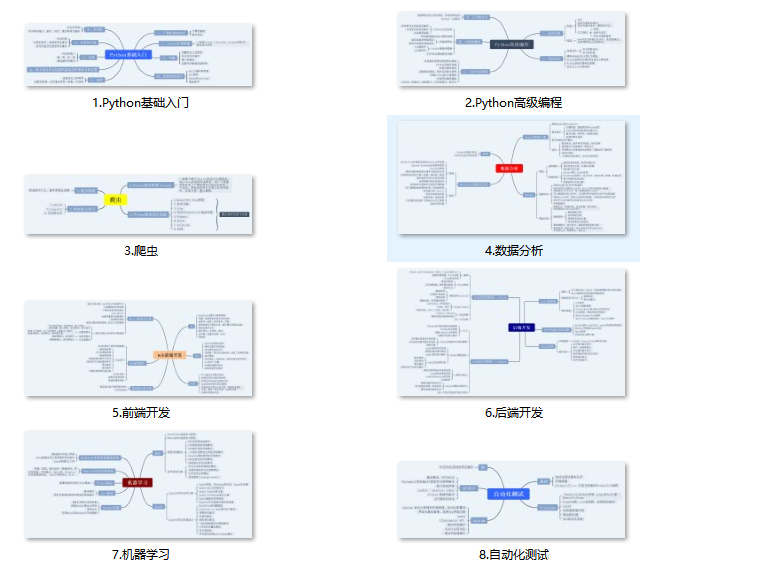如果你也是看准了Python,想自学Python,在这里为大家准备了丰厚的免费学习大礼包,带大家一起学习,给大家剖析Python兼职、就业行情前景的这些事儿。
一、Python所有方向的学习路线
Python所有方向路线就是把Python常用的技术点做整理,形成各个领域的知识点汇总,它的用处就在于,你可以按照上面的知识点去找对应的学习资源,保证自己学得较为全面。

二、学习软件
工欲善其必先利其器。学习Python常用的开发软件都在这里了,给大家节省了很多时间。

三、全套PDF电子书
书籍的好处就在于权威和体系健全,刚开始学习的时候你可以只看视频或者听某个人讲课,但等你学完之后,你觉得你掌握了,这时候建议还是得去看一下书籍,看权威技术书籍也是每个程序员必经之路。

四、入门学习视频
我们在看视频学习的时候,不能光动眼动脑不动手,比较科学的学习方法是在理解之后运用它们,这时候练手项目就很适合了。


四、实战案例
光学理论是没用的,要学会跟着一起敲,要动手实操,才能将自己的所学运用到实际当中去,这时候可以搞点实战案例来学习。

五、面试资料
我们学习Python必然是为了找到高薪的工作,下面这些面试题是来自阿里、腾讯、字节等一线互联网大厂最新的面试资料,并且有阿里大佬给出了权威的解答,刷完这一套面试资料相信大家都能找到满意的工作。

成为一个Python程序员专家或许需要花费数年时间,但是打下坚实的基础只要几周就可以,如果你按照我提供的学习路线以及资料有意识地去实践,你就有很大可能成功!
最后祝你好运!!!
网上学习资料一大堆,但如果学到的知识不成体系,遇到问题时只是浅尝辄止,不再深入研究,那么很难做到真正的技术提升。
一个人可以走的很快,但一群人才能走的更远!不论你是正从事IT行业的老鸟或是对IT行业感兴趣的新人,都欢迎加入我们的的圈子(技术交流、学习资源、职场吐槽、大厂内推、面试辅导),让我们一起学习成长!
1 in a
True
###### The upper(), lower(), isupper(), islower() string methods
check = ‘Hello world!’
check = check.lower() ## converts check to lower
check
‘hello world!’
check = check.isupper() ## checks whether check variable is upper or not.
False
check = check.islower() ## checks whether check variable is upper or not.
True
check = check.upper() ## converts check to upper
check
‘HELLO WORLD!’
check = check.isupper() ## checks whether check variable is upper or not.
True
check = check.islower() ## checks whether check variable is upper or not.
False
###### Template Strings
模板字符串是一种更简单的机制,用于处理用户生成的格式字符串
from string import Template
language = ‘Python’
t = Template(‘$name is great!’)
t.substitute(name=language) ## Substitutes name with language variable
‘Python is great!’
#####Pyperclip
Pyperclip是一个Python库,可以帮助我们轻松复制和粘贴字符串
首先使用pip安装
pip install pyperclip
```
import pyperclip
pyperclip.copy(‘Hello World’) ## Copy Hello World
pyperclip.paste()
‘Hello World’
##### Number
Python中有三种数字类型
* int (e.g. 2, 4, 20)
bool (e.g. False and True, acting like 0 and 1)
* float (e.g. 5.0, 1.6)
* complex (e.g. 5+6j, 4-3j)
###### Basic Functions
a = pow(2, 3) ## Or: 2 ** 3
b = abs(5) ## = abs()
###### Constants
from math import e, pi
###### Trigonometry
from math import cos, acos, sin, asin, tan, atan, degrees, radians
###### Logarithm
from math import log, log10, log2
= log( [, base]) # Base e, if not specified.
###### Infinity, nan
from math import inf, nan, isinf, isnan
###### Or:
float(‘inf’), float(‘nan’)
###### Statistics
from statistics import mean, median, variance, pvariance, pstdev
###### Random
from random import random, randint, choice, shuffle
= random()
= randint(from_inclusive, to_inclusive)
= choice()
shuffle()
##### Combinatorics
每个函数都返回一个迭代器。
如果要打印迭代器,需要将其传递给list()函数!
from itertools import product, combinations, combinations_with_replacement, permutations
product([0, 1], repeat=3)
[(0, 0, 0), (0, 0, 1), (0, 1, 0), (0, 1, 1),
(1, 0, 0), (1, 0, 1), (1, 1, 0), (1, 1, 1)]
product(‘ab’, ‘12’)
[(‘a’, ‘1’), (‘a’, ‘2’),
(‘b’, ‘1’), (‘b’, ‘2’)]
combinations(‘abc’, 2)
[(‘a’, ‘b’), (‘a’, ‘c’), (‘b’, ‘c’)]
combinations_with_replacement(‘abc’, 2)
[(‘a’, ‘a’), (‘a’, ‘b’), (‘a’, ‘c’),
(‘b’, ‘b’), (‘b’, ‘c’),
(‘c’, ‘c’)]
permutations(‘abc’, 2)
[(‘a’, ‘b’), (‘a’, ‘c’),
(‘b’, ‘a’), (‘b’, ‘c’),
(‘c’, ‘a’), (‘c’, ‘b’)]
“”"
def test_integer_numbers():
“”“Integer type
Int, or integer, is a whole number, positive or negative,
without decimals, of unlimited length.
“””
positive_integer = 1
negative_integer = -3255522
big_integer = 35656222554887711
assert isinstance(positive_integer, int)
assert isinstance(negative_integer, int)
assert isinstance(big_integer, int)
def test_booleans():
“”“Boolean
Booleans represent the truth values False and True. The two objects representing the values
False and True are the only Boolean objects. The Boolean type is a subtype of the integer type,
and Boolean values behave like the values 0 and 1, respectively, in almost all contexts, the
exception being that when converted to a string, the strings “False” or “True” are returned,
respectively.
“””
true_boolean = True
false_boolean = False
assert true_boolean
assert not false_boolean
assert isinstance(true_boolean, bool)
assert isinstance(false_boolean, bool)
# Let's try to cast boolean to string.
assert str(true_boolean) == "True"
assert str(false_boolean) == "False"
def test_float_numbers():
“”“Float type
Float, or “floating point number” is a number, positive or negative,
containing one or more decimals.
“””
float_number = 7.0
# Another way of declaring float is using float() function.
float_number_via_function = float(7)
float_negative = -35.59
assert float_number == float_number_via_function
assert isinstance(float_number, float)
assert isinstance(float_number_via_function, float)
assert isinstance(float_negative, float)
# Float can also be scientific numbers with an "e" to indicate
# the power of 10.
float_with_small_e = 35e3
float_with_big_e = 12E4
assert float_with_small_e == 35000
assert float_with_big_e == 120000
assert isinstance(12E4, float)
assert isinstance(-87.7e100, float)
def test_complex_numbers():
“”“Complex Type”“”
complex_number_1 = 5 + 6j
complex_number_2 = 3 - 2j
assert isinstance(complex_number_1, complex)
assert isinstance(complex_number_2, complex)
assert complex_number_1 * complex_number_2 == 27 + 8j
def test_number_operators():
“”“Basic operations”“”
# Addition.
assert 2 + 4 == 6
# Multiplication.
assert 2 * 4 == 8
# Division always returns a floating point number.
assert 12 / 3 == 4.0
assert 12 / 5 == 2.4
assert 17 / 3 == 5.666666666666667
# Modulo operator returns the remainder of the division.
assert 12 % 3 == 0
assert 13 % 3 == 1
# Floor division discards the fractional part.
assert 17 // 3 == 5
# Raising the number to specific power.
assert 5 ** 2 == 25 # 5 squared
assert 2 ** 7 == 128 # 2 to the power of 7
# There is full support for floating point; operators with
# mixed type operands convert the integer operand to floating point.
assert 4 * 3.75 - 1 == 14.0
#####
#####
**File**
* Read File
* Write a File
* Copy File
* Move File
* Readline
###### Read a file
在Python 3中,如果文件未以二进制模式打开,则编码将由locale.getpreferredencoding(False)或用户输入确定。
with open(“/etc/hosts”, encoding=“utf-8”) as f:
… content = f.read()
…
print(type(content))
<class ‘str’>
In python3 binary mode
with open(“/etc/hosts”, “rb”) as f:
… content = f.read()
…
print(type(content))
<class ‘bytes’>
In python2
The content of the file is a byte string, not a Unicode string.
with open(“/etc/passwd”) as f:
… content = f.read()
print(type(content))
<type ‘str’>
print(type(content.decode(“utf-8”)))
<type ‘unicode’>
###### Write a File
file_content = “Python is great!”
with open(“check.txt”, “w”) as file:
… file.write(file_content)
###### Copy a file
from distutils.file_util import copy_file
copy_file(“a”, “b”)
(‘b’, 1)
###### Move a File
from distutils.file_util import move_file
move_file(“./a”, “./b”)
‘./b’
###### Readline
If you are not using linux machine try to change the file path to read
with open(“/etc/hosts”) as f:
… for line in f:
… print(line, end=‘’)
…
127.0.0.1 localhost
255.255.255.255 broadcasthost
::1 localhost
**Python Functions**
* Lambda
* Declare Function
* Document Function
* Get Function Name
* Arguments
* Decorator
* Generator
###### Lambda
fn = lambda x: x**3
fn(2)
8
(lambda x: x**3)(2)
8
(lambda x: [x * _ for _ in range(10)])(3)
[0, 3, 6, 9, 12, 15, 18, 21, 24, 27]
###### Declare Function
def fn_name(): ## Where fn_name represents the function name
…
…
###### Get Function Name
First Declare a function
def fn_name():
…
…
fn_name.name
‘fn_name’
###### Document a Function
Document a function with three single quotes
def check():
‘’‘This function is documented’‘’
return
check.doc
‘This function is documented’
###### Arguments
def multiply(a, b=0): ## b is 0 by default
… return a * b
…
multiply(1, 3) ## 3 * 1
3
multiply(5) ## 5 * 0
0
multiply(5, b=3) ## 5 * 3
15
###### Generator
def count(start, step):
while True:
yield start
start += step
counter = count(10, 5)
next(counter)
(15)
next(counter) ## Increments by 5 from the previous result
(20)
next(counter)
(25)
next(counter), next(counter), next(counter)
(30, 35, 40)
###### Decorator
from functools import wraps
def decorator_func(func):
… @wraps(func)
… def wrapper(*args, **kwargs):
… print(“Before calling {}.”.format(func.name))
… ret = func(*args, **kwargs)
… print(“After calling {}.”.format(func.name))
… return ret
… return wrapper
…
@decorator_func
… def check():
… print(“Inside check function.”)
…
check()
Before calling check.
Inside check function.
After calling check.
**Classes**
* Definition
* Class Objects
* Instance Objects
* Method Objects
* Inheritance
* Multiple Inheritance
Class Definition
Python是一种面向对象的编程语言。 Python中的几乎所有东西都是一个对象,具有其属性和方法。 Class类似于对象构造函数,或者是用于创建对象的“蓝图”。
def test_class():
“”“Class definition.”“”
# Class definitions, like function definitions (def statements) must be executed before they
# have any effect. (You could conceivably place a class definition in a branch of an if
# statement, or inside a function.)
class GreetingClass:
"""Example of the class definition
This class contains two public methods and doesn't contain constructor.
"""
name = 'Bisrat'
def say_hello(self):
"""Class method."""
# The self parameter is a reference to the class itself, and is used to access variables
# that belongs to the class. It does not have to be named self , you can call it
# whatever you like, but it has to be the first parameter of any function in the class.
return 'Hello ' + self.name
def say_goodbye(self):
"""Class method."""
return 'Goodbye ' + self.name
# When a class definition is entered, a new namespace is created, and used as the local scope —
# thus, all assignments to local variables go into this new namespace. In particular, function
# definitions bind the name of the new function here.
# Class instantiation uses function notation. Just pretend that the class object is a
# parameterless function that returns a new instance of the class. For example the following
# code will creates a new instance of the class and assigns this object to the local variable.
greeter = GreetingClass()
assert greeter.say_hello() == 'Hello Bisrat'
assert greeter.say_goodbye() == 'Goodbye Bisrat'
print(type(content))
<class ‘str’>
**Class Objects**
def test_class_objects():
“”“Class Objects.
Class objects support two kinds of operations:
- attribute references
- instantiation.
“””
# ATTRIBUTE REFERENCES use the standard syntax used for all attribute references in
# Python: obj.name. Valid attribute names are all the names that were in the class’s namespace
# when the class object was created. For class MyCounter the following references are valid
# attribute references:
class ComplexNumber:
"""Example of the complex numbers class"""
real = 0
imaginary = 0
def get_real(self):
"""Return real part of complex number."""
return self.real
def get_imaginary(self):
"""Return imaginary part of complex number."""
return self.imaginary
assert ComplexNumber.real == 0
# __doc__ is also a valid attribute, returning the docstring belonging to the class
assert ComplexNumber.__doc__ == 'Example of the complex numbers class'
# Class attributes can also be assigned to, so you can change the value of
# ComplexNumber.counter by assignment.
ComplexNumber.real = 10
assert ComplexNumber.real == 10
# CLASS INSTANTIATION uses function notation. Just pretend that the class object is a
# parameterless function that returns a new instance of the class. For example
# (assuming the above class):
complex_number = ComplexNumber()
assert complex_number.real == 10
assert complex_number.get_real() == 10
# Let's change counter default value back.
ComplexNumber.real = 10
assert ComplexNumber.real == 10
# The instantiation operation (“calling” a class object) creates an empty object. Many classes
# like to create objects with instances customized to a specific initial state. Therefore a
# class may define a special method named __init__(), like this:
class ComplexNumberWithConstructor:
"""Example of the class with constructor"""
def __init__(self, real_part, imaginary_part):
self.real = real_part
self.imaginary = imaginary_part
def get_real(self):
"""Return real part of complex number."""
return self.real
def get_imaginary(self):
"""Return imaginary part of complex number."""
return self.imaginary
complex_number = ComplexNumberWithConstructor(3.0, -4.5)
assert complex_number.real, complex_number.imaginary == (3.0, -4.5)
#### **Instance Object**
def test_instance_objects():
# DATA ATTRIBUTES need not be declared; like local variables, they spring into existence when
# they are first assigned to. For example, if x is the instance of MyCounter created above,
# the following piece of code will print the value 16, without leaving a trace.
# pylint: disable=too-few-public-methods
class DummyClass:
pass
dummy_instance = DummyClass()
# pylint: disable=attribute-defined-outside-init
dummy_instance.temporary_attribute = 1
assert dummy_instance.temporary_attribute == 1
del dummy_instance.temporary_attribute
**Method Objects**
class MyCounter:
“”“A simple example of the counter class”“”
counter = 10
def get_counter(self):
"""Return the counter"""
return self.counter
def increment_counter(self):
"""Increment the counter"""
self.counter += 1
return self.counter
def test_method_objects():
“”“Method Objects.”“”
# object types can have methods as well. For example, list objects have methods called append,
counter = MyCounter()
assert counter.get_counter() == 10
get_counter = counter.get_counter
assert get_counter() == 10
assert counter.get_counter() == 10
assert MyCounter.get_counter(counter) == 10
**Inheritance**
pylint: disable=too-few-public-methods
class Person:
“”“Example of the base class”“”
def init(self, name):
self.name = name
def get_name(self):
"""Get person name"""
return self.name
The syntax for a derived class definition looks like this.
class Employee(Person):
def __init__(self, name, staff_id):
Person.__init__(self, name)
# You may also use super() here in order to avoid explicit using of parent class name:
# >>> super().__init__(name)
self.staff_id = staff_id
def get_full_id(self):
"""Get full employee id"""
return self.get_name() + ', ' + self.staff_id
def test_inheritance():
“”“Inheritance.”“”
# There’s nothing special about instantiation of derived classes: DerivedClassName() creates a
# new instance of the class. Method references are resolved as follows: the corresponding class
# attribute is searched, descending down the chain of base classes if necessary, and the method
# reference is valid if this yields a function object.
person = Person('Bisrat')
employee = Employee('John', 'A23')
assert person.get_name() == 'Bisrat'
assert employee.get_name() == 'John'
assert employee.get_full_id() == 'John, A23'
# Python has two built-in functions that work with inheritance:
#
# - Use isinstance() to check an instance’s type: isinstance(obj, int) will be True only if
# obj.__class__ is int or some class derived from int.
#
# - Use issubclass() to check class inheritance: issubclass(bool, int) is True since bool is
# a subclass of int. However, issubclass(float, int) is False since float is not a subclass
# of int.
assert isinstance(employee, Employee)
assert not isinstance(person, Employee)
assert isinstance(person, Person)
assert isinstance(employee, Person)
assert issubclass(Employee, Person)
assert not issubclass(Person, Employee)
**Multiple Inheritance**
def test_multiple_inheritance():
“”“Multiple Inheritance”“”
class Clock:
“”“Clock class”“”
time = '10:17 PM'
def get_time(self):
"""Get current time
Method is hardcoded just for multiple inheritance illustration.
"""
return self.time
class Calendar:
"""Calendar class"""
date = '12/08/2018'
def get_date(self):
"""Get current date
Method is hardcoded just for multiple inheritance illustration.
"""
return self.date
# Python supports a form of multiple inheritance as well. A class definition with multiple
# base classes looks like this.
class CalendarClock(Clock, Calendar):
calendar_clock = CalendarClock()
assert calendar_clock.get_date() == '12/08/2018'
assert calendar_clock.get_time() == '11:23 PM'
**Date and Time**
现在能在网上找到很多很多的学习资源,有免费的也有收费的,当我拿到1套比较全的学习资源之前,我并没着急去看第1节,我而是去审视这套资源是否值得学习,有时候也会去问一些学长的意见,如果可以之后,我会对这套学习资源做1个学习计划,我的学习计划主要包括规划图和学习进度表。
分享给大家这份我薅到的免费视频资料,质量还不错,大家可以跟着学习

**网上学习资料一大堆,但如果学到的知识不成体系,遇到问题时只是浅尝辄止,不再深入研究,那么很难做到真正的技术提升。**
**[需要这份系统化学习资料的朋友,可以戳这里获取](https://bbs.csdn.net/forums/4304bb5a486d4c3ab8389e65ecb71ac0)**
**一个人可以走的很快,但一群人才能走的更远!不论你是正从事IT行业的老鸟或是对IT行业感兴趣的新人,都欢迎加入我们的的圈子(技术交流、学习资源、职场吐槽、大厂内推、面试辅导),让我们一起学习成长!**
























 113
113

 被折叠的 条评论
为什么被折叠?
被折叠的 条评论
为什么被折叠?








